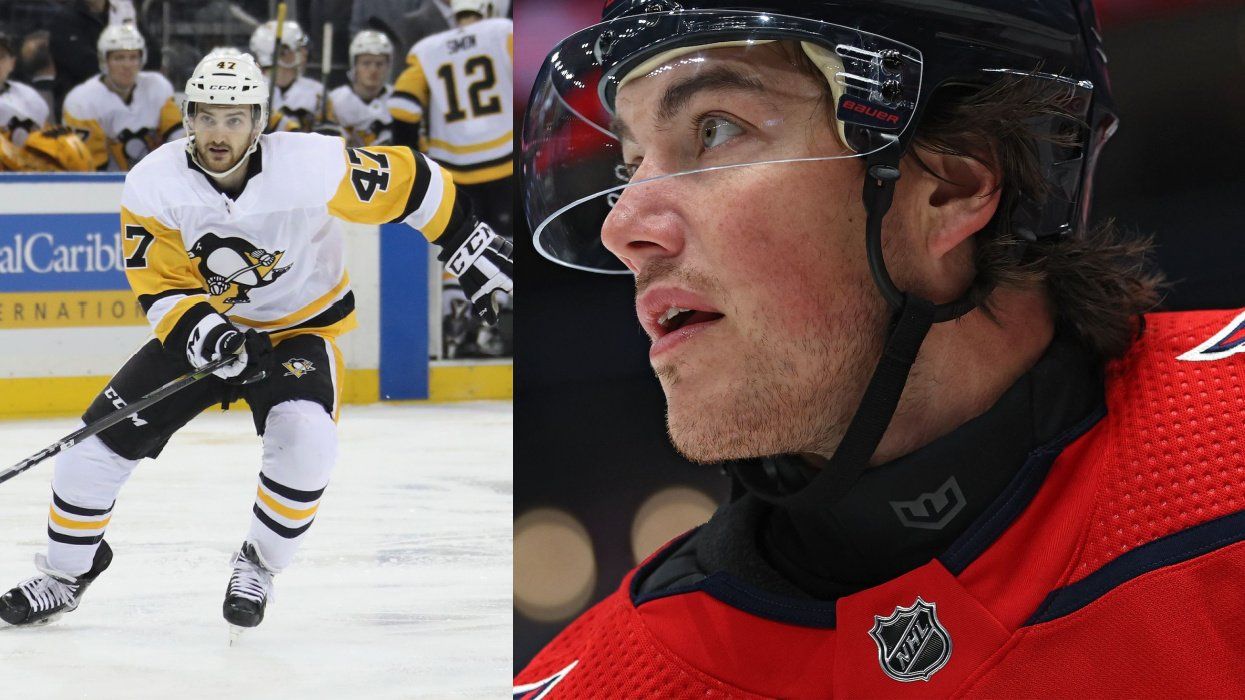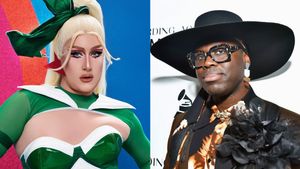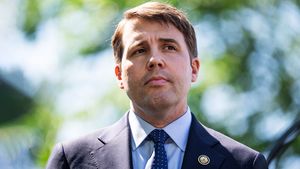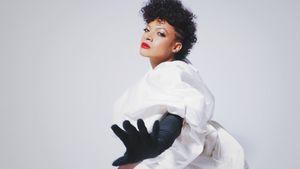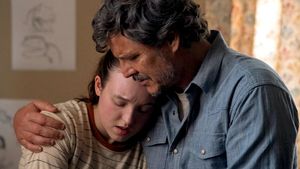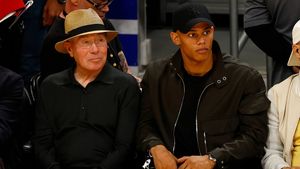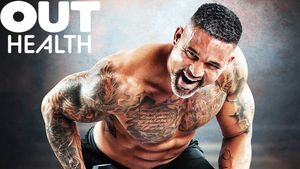(CNN) — A “crazy amount of emotions” ran through TJ Oshie’s mind as he watched footage of what would be American hockey player Adam Johnson’s final moments on the ice.
After keeping Johnson and the 29-year-old’s family in his thoughts, Oshie – a winger with the NHL’s Washington Capitals and co-founder of a hockey apparel company – said that his focus turned to how often he overlooks his own sense of self-preservation while competing at the top of the sport.
“Sometimes, you feel like you’re invincible on the ice,” the 36-year-old tells CNN Sport. “I tend to go at things head-first – slide in and worry about my injuries later.”
Days after Johnson’s death, which was described by his team as a “freak accident,” Oshie opted to wear an undershirt his company developed with a built-in protective guard around his neck for the Capitals’ game against the New York Islanders on November 2.
His decision came at a time when there is much discussion within the hockey community about neck guards, particularly given the circumstances around Johnson’s death in the UK.
A Sheffield coroner’s report found that the Nottingham Panthers player “sustained an incised wound to the neck caused by the skate of another player” and later died in hospital as a result of the injury.
The Panthers had been playing the Sheffield Steelers on October 28 when Johnson was involved in a collision with an opposition player. Spectators were asked to leave the Utilita Arena in Sheffield and the match was immediately suspended.
“I thought about my kids,” Oshie says about wearing a neck guard as he reflects on Johnson’s death. “I’m getting towards the end of my career, and I just wanted to take that extra step to protect myself and protect their dad’s future.”
Several of his Capitals teammates have also been wearing cut-resistant neck guards in recent weeks, Oshie says, while some organizations have moved to mandate neck protection.
The English Ice Hockey Association has announced that all players must wear neck guards from the start of next year, and the Pittsburgh Penguins, Johnson’s former NHL team, are mandating neck guards for their minor league players, coach Mike Sullivan has said.
Sheffield coroner Tanyka Rawden said in her report that she is “sufficiently concerned that deaths may occur in the future” if neck guards are not worn, adding that her inquest will determine whether neck protection could have prevented Johnson’s death.
In the NHL, neck guards – let alone neck coverings of any kind – are not a common sight.
“I think there is a machismo within ice hockey where you’re seen as being something less if you choose to wear more protective equipment,” ice hockey broadcaster Seth Bennett tells CNN Sport.
“A lot of players would think that wearing a neck guard is more to do with getting a puck in the neck and trying to protect your larynx as much as a skate blade … There isn’t a thought process that this is something that is a vital piece of equipment.”
In the UK, where he also coaches youth ice hockey, Bennett says that he has seen senior players wear neck guards only when it satisfies an insurance requirement. He also believes that the sport and its players should do more to prioritize safety on the ice.
“It’s horrific that somebody died,” says Bennett. “It would be even worse if the sport stood with its fingers in its ears and its eyes closed.”
Neck guard demand grows
Currently, the International Ice Hockey Federation only mandates neck guards for junior players and recommends that all other players wear them on the ice, but it’s down to individual leagues and governing bodies to decide whether to make them compulsory in the games they oversee.
NHL commissioner Gary Bettman told reporters earlier this month that introducing neck guards either through a mandate or on a “phased-in basis” is something that the league will discuss with the players’ association. He added that players have the right to make some decisions themselves.
USA Hockey, meanwhile, recommends that all players wear a guard which “covers as much of the neck area as possible,” noting that this sort of protection does not “eliminate the risk” of a laceration.
“I will say that hockey players are stubborn historically, and a lot of guys probably won’t try it or won’t wear it,” says 2018 Stanley Cup champion Oshie. “But I think you will see a lot more guys at least giving it a go on a practice or trying it on off the ice.”
Oshie – whose NHL career has so far spanned 16 seasons and nearly 1,000 games – founded his own hockey apparel company, Warroad, in 2018, and he has recently been sporting the brand’s neck guard at practices and during games.
Warroad’s neck guards are fitted with Kevlar and steel components, ensuring that they have enough stiffness to stay upright and offer effective coverage around the neck.
There has been huge demand for the company’s neck and wrist guards in recent weeks as professional and amateur players alike seek out more protective gear, according to Jason Olden, a Warroad co-founder.
“We built about 2,800 units,” Olden tells CNN Sport. “In about a 12-hour period, we’ve moved through all of our inventory of the neck and wrist product.”
He added: “Ultimately, it’s a bit of a frenzy from a supply chain standpoint because, now, we want to get as many players protected as quickly as we can, and we’re going to have constant rolling production for the foreseeable future.”
Other brands have also restated their commitment to player safety after Johnson’s death.
“This is lifesaving technology,” Mary-Kay Messier, VP of global marketing for Bauer Hockey, tells CNN Sport. “And there are products in the market that work and we’re seeing them being adopted now. I think we need to continue to develop products [and] continue to make them more comfortable to ensure player adoption.”
Bauer Hockey has also seen the demand for neck guards grow in the wake of Johnson’s death.
“What we have seen is a huge demand from retailers ramping up for consumer demand,” says Messier. “We have taken every channel that we can to ensure the availability, including airfreighting product over to meet the demand and ramping up production.”
An evolving stance of safety
The infrequency with which neck laceration injuries occur in hockey, alongside feeling that guards are ineffective or uncomfortable, are some of the reasons that players aren’t consistently wearing protection around the throat.
Despite being a rare occurrence in hockey, there is a history of serious neck-cut injuries happening in the sport.
Last year, high school hockey player Teddy Balkind died after another player’s skate cut his neck, while Florida Panthers forward Richard Zednik needed emergency surgery after sustaining a neck slash against the Buffalo Sabres in 2008.
That last incident triggered debilitating PTSD for former NHL goaltender Clint Malarchuk, who almost died from a cut to the neck following an on-ice collision in 1989.
“It’s big, big anxiety,” Malarchuk told The Athletic after learning about Johnson’s death, adding that he now has the “tools” to deal with the lingering mental anguish from his own neck laceration.
The circumstances around Johnson’s death, like other similar occurrences in the sport, have only strengthened calls for neck guards to be worn more widely.
“I view these tragedies as an impetus for change,” Dr. Mike Stuart, chief medical officer at USA Hockey and chair of its Safety and Protective Equipment Committee, tells CNN Sport.
“There’s a real heightened awareness now that these lacerations can occur to the body. And there’s already been, I think, some real renewed interest, if you will, where leagues are starting to mandate and players and parents are ordering cut resistance products at a record pace.”
Stuart believes that more work needs to be done to improve the overall quality of neck guards, some of which he thinks are too thin, not wide enough, prone to sliding down the neck and/or liable to shrinking in the wash.
“The protective device should literally go from the ear down to the collarbone because it needs to protect the area underneath the angle of the mandible (the lower jaw) and the area right above the collarbone where there’s also neurovascular structures,” he says.
One way to make neck guards and other protective equipment more widely worn would be to introduce mandates for players of a certain age, which is similar to how helmets became compulsory in the NHL.
At the time, a mandate was introduced for players who signed professional contracts after June 1, 1979, to wear a helmet, taking the element of choice away from the players.
“I have experienced player reluctance to wear protective equipment with everything we’ve tried to do in the area of safety,” says Stuart, “and that has to do even with facial protection and with other types of protective equipment.
“There is still freedom of choice in the National Hockey League and there are players that warm up before games without helmets; there used to be players who wear no facial protection and there are current players who wear visors totally ineffectively.”
However, Stuart says that he remains “very optimistic” that, with education, player attitudes towards safety can evolve over time and protective equipment like neck guards can become more widely worn.
Oshie says that those shifts in attitude toward safety are ongoing.
“We are hesitant to maybe get away from the old ways a little bit more,” says Oshie, “and I don’t know if that’s because we watched the guys before us, we looked up to the players who were veterans when we came in as rookies.
“But it does look like, especially as the kids are growing up and the game gets younger and younger, that they are willing to adapt a little bit more than maybe the generations before them.”
The-CNN-Wire
™ & © 2023 Cable News Network, Inc., a Warner Bros. Discovery Company. All rights reserved.
Breaking down the NHL pride ban

Video Source: Advocate Channel
- The NHL Demonstrates Why LGBTQ+ Players Stay in the Closet ›
- Another Former Player Sues the Chicago Blackhawks For Sexual Assault by a Former Coach ›
- NHL Pride Jerseys Abandoned by Teams After Conservative Pushback ›
- Does the NHL Have a Gambling Double-Standard? Fans Poke Fun at Shane Pinto's 'Ironic' Suspension ›
